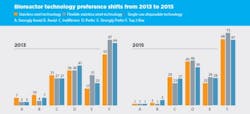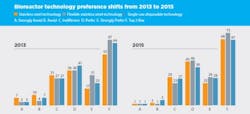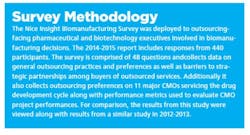Editor’s note: This piece, part of a two part series, originally appeared as a sidebar to the cover story, Pharmaceutical Tools of the Trade. In Part 2, That’s Nice researchers take a close look at the remaining three companies that round off the top five market players for single-use bioreactors. That’s Nice will also share its insight on geographical market preferences for bioreactors and bioreactor preferences based on cell line platforms.
Considering the capacious amount of time and resources an organization invests in bringing a biologic to market, bioreactor selection is one of the crucial manufacturing decisions for an organization. Unlike small molecule, the cost of production plays a vital role in the pricing of biologics. Any cost-saving measures implemented at the manufacturing stage translate to substantial profits. Single-use bioreactors have come a long way since their inception, when single-use was considered revolutionary. Single-use technology has established itself as a popular choice at the preclinical/clinical production stage, and is well on its way to becoming a reliable alternative at the commercial manufacturing stage.
The results from a recently concluded Nice Insight survey quantified the slow induction of single-use bioreactors in the mainstream market. Respondents (biologics outsourcers) were asked about their reactor technology preferences, and there was an almost equal preference for the two types of reactors: stainless-steel and single-use disposable reactors (68% vs. 67%, respectively). There are a few kinks that need to be ironed out, namely the cytotoxicity risks, before single-use reactors can be considered as a standard alternative to the stainless-steel reactors. But given the stringent, methodical and conservative nature of the biopharmaceutical industry, innovative techniques have to pass the rigors of tests, approvals and time before becoming an acceptable standard of operation. The future looks promising for single-use bioreactors; industry analysts have predicted the global single-use bioreactor market to more than double in the next 5 years.
So what exactly does bioreactor preferences mean to outsourcers? Does one select CMOs and realign their bioreactor preferences based on the types of bioreactors offered by the CMO or pick a CMO with equipment that matches their preferences? There are advantages and drawbacks to both options.
Bioreactor selection is a very customized, case-by-case process that is dependent on multiple variables. A CMO may possess state-of-the-art single-use bioreactors, but if the outsourcer requires large 20,000 L stainless-steel reactors to complement a similar setup in-house, the state-of-the-art single-use reactors with 250L capacity will not help the outsourcer. However, a mix of multiple 2000L single-use stirred tank bioreactors along with some traditional SS reactors will give the outsourcer the confidence in CMO’s ability to fulfill its goals.
CMO BIOREACTOR PREFERENCE
On the flipside, what is the significance of bioreactor preferences for a CMO? Understanding bioreactor preferences and staying abreast with the industry demands gives the CMO a competitive advantage over other companies vying for business. CMOs need to make sure they have the right setup along with the technical expertise, know-how and personnel to match the reactors. Having the right mix of reactors (stainless steel, flexible, single-use, different capacities) and the right number of reactors will help CMOs win projects/businesses from sponsors.
2013 TO 2015 TRENDS
Year-to-year comparisons revealed that bioreactor preferences have strengthened over the past two years, particularly for single-use disposable technology and the more traditional stainless-steel technology. For the single-use disposable reactors there was a 5 percent point increase in “Strongly Prefer” over the two years whereas the preference for stainless-steel technology showed a 6 percent point increase for “Strongly Prefer” over the same time period.
GE HEALTHCARE LIFE SCIENCES WAVE BIOREACTOR SYSTEM 500/1000
The WAVE bioreactor was a pioneering discovery by Dr. Vijay Singh in the late ’90s; it was one of the first successful attempts to move from stainless-steel to single-use plastic bags, thus developing a new type of single-use bioreactor. It is available in three different sizes: 20/50 L, 200 L and 500/1000 L, depending on the needs and requirements. The 200 L and 500/1000 L are designed for cGMP manufacturing. One of the technology’s key benefits is the negligible sheer produced in comparison to the stirred-tank bioreactors, making it an ideal bioreactor platform for sheer-sensitive cells.
XCELLEREX XDR
The XDR system is based on similar principles as a conventional stainless-steel bioreactor. It is a stirred-tank system based on measures such as sheer, tip speed, power and fluid velocity. Available in multiple sizes from bench top lab scale 10L to cGMP commercial manufacturing scale 2000L, the XDR was originally developed for in-house contract manufacturing duty. The design resemblance to a traditional stainless-steel reactor helps with the smooth transition from a process development scale to a larger manufacturing scale. The XDR-50 MO fermenter system was designed as a single-use stirred-tank fermenter for microbial culturing. The system has proven successful with multiple microbial cell culture lines such as E. coli, Pseudomonas and Saccharomyces.
HYPERFORMA SINGLE-USE BIOREACTOR
The HyPerforma SUB system is based on the HyClone system with some enhanced improvements like a 2:1 turndown ratio that ensures consistent scalability for final production. Like the HyClone, HyPerforma is also available in all sizes ranging from 50L to 2000L.
REFERENCES
“Single Use Bioreactor Market worth $470.9 Million by 2019, According to a New Study on ASDReports”
Thermo Scientific
“HyPerforma™ Single-Use Bioreactors.”
GE Healthcare Life Sciences
“Xcellerex XDR-50 to 2000 Single-Use Bioreactor System.”
“Wave Bioreactor Story”
“Wave Bioreactor System 500/1000”








